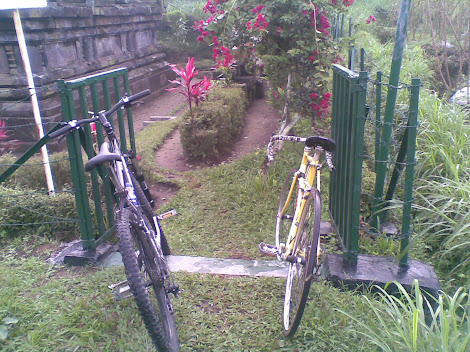In contrast to the magnificent Borobudur temple which stood in a spacious complex, Asu temple buildings and temple located in the Village Pendem Sengi, Shaman District, Magelang District, it was almost hidden. In addition to the lack of signage pointing the location, these two temples were closed by high grass and weeds of rice farmland and chili hem on all sides.
Candi Asu relatively easily found because only about five feet from the asphalt road. However, the roadside scenery interrupted because of heavy grass weeds. Once inside the temple complex, which has size 10 x 10 meters, visitors can immediately see areas of chilli plants, which yesterday had not yet picked the fruit right in front-wire fence surrounding the temple.
Moreover, as far as the eye could see, the right side, left, and back also seemed filled with paddy fields and various other horticultural crops. Once inside, visitors would feel cramped and hard to move because of the distance between the boundary fence of the temple with only about two kilometers.
Jumad (42), interpreters keep Candi Asu, Temple Pendem, and Candi Lumbung, say, the only expansion efforts Asu temple complex ever undertaken Archaeological Heritage Protection Center (BP3), Central Java, just widen the entrance to the temple.
Previously, the entrance to the temple is very narrow and can only be crossed by one person. However, during the last ten years, eventually widened the driveway and be able to pass two people, he said.
Asu temple is a temple of Hindu heritage. The word comes from the word Aswa Asu, Sanskrit, which means rest. Seeing the home he said, the temple was allegedly built to be a resting place.
"However, by looking at the shape of the building when found, allegedly built the temple was not finished," he said.
To visit the Temple Pendem, way to go further and winding. Because it provided no special access, then those who want to see this temple must menenpuh travel with the rice field along the extent of about one kilometer.
Once on location, this temple as if it was buried or hidden because it is located about two meters below the dike. Pendem name itself is a new name given by locals because it was found buried beneath the fields.
At the location of the two temples are mounted sign which confirms the existence of the two temples as objects of cultural heritage. Besides, it has also posted excerpts of Act No. 5 of 1992 on Objects of Cultural Property which contains the threat of punishment for those who destroy or steal these objects.
However, at two sites, completely absent from the guard post to protect the temple from various acts of theft or vandalism.
Efforts to safeguard the temple simply rely on the activity siskamling or village security patrols, he said. Outside of its patrols, security efforts also depend on the observation and monitoring by local people.
Jumad said the possibility of theft in Candi Asu, Pendem, and the barn is very small. Because, in the three temples are rarely there is a relief or sculpture, which costs dearly for sale.
"If there's relief, the relative position of its rock hard to take," he explained.
Jumad pet who has become an interpreter since 1990 claiming that the three temples was unprecedented theft of stone temples. Cases the loss of a few rocks, he says, only occurs during the Dutch colonization.
This condition is clearly different from Borobudur Temple. Buddha relic temple heralded as the world's cultural heritage is kept closely guarded, and even on certain occasions such as before execution of Bali bombers Amrozi et al, and on New Year's Eve, security officers continually added
Wednesday, September 22, 2010
Subscribe to:
Post Comments (Atom)
.jpg)


No comments:
Post a Comment